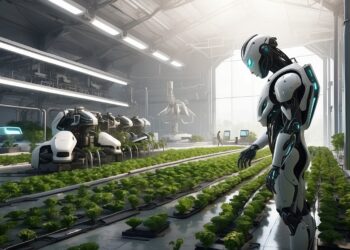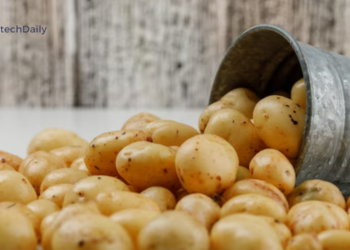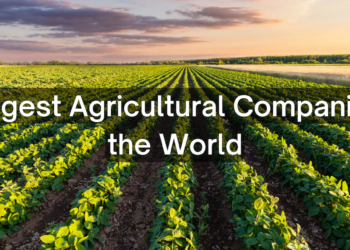Agriculture has come a long way from traditional farming methods. With the advent of new technologies, the industry has been able to take huge strides in terms of efficiency, yield, and cost-effectiveness. One such technological advancement that has been making waves in recent years is the use of drones and robotics in agriculture.
The application of drones and robotics in agriculture offers numerous benefits, from increased accuracy in crop management to a reduction in the need for manual labor.
Applications of Drones in Agriculture:
Drones in agriculture, also known as unmanned aerial vehicles (UAVs), are becoming increasingly popular in the farming industry due to their ability to gather data, monitor crops, and perform various tasks.

They are equipped with various sensors, cameras, and mapping tools to provide farmers with detailed information about crop health, soil moisture, and more. With this data, farmers can make informed decisions about fertilization, irrigation, and pest management.
Additionally, drones can also be used for tasks such as crop spraying, planting seeds, and even monitoring livestock. This can help reduce manual labor and increase efficiency while also providing a safer and more environmentally friendly solution.
The use of drones in agriculture can also provide farmers with real-time data, allowing them to make quick and effective decisions to improve yields and reduce costs. With the increasing demand for food production, the use of drones in agriculture is seen as a key solution for supporting sustainable
- Crop Scouting: One of the primary applications of drones in agriculture is crop scouting. With the use of drones, farmers can quickly and easily survey their crops and get an aerial view of their fields. This can be useful in identifying potential issues with the crops, such as pest infestations or nutrient deficiencies, allowing farmers to take proactive measures to address these issues before they become major problems.
- Crop Mapping: Another application of drones in agriculture is crop mapping. By using aerial imagery, farmers can create highly detailed maps of their fields, which can be used to identify areas of the field that may need special attention. This information can be used to create fertilization plans, as well as to develop more efficient irrigation systems.
- Crop Spraying: Drones can also be used for crop spraying, which can be a more efficient and cost-effective alternative to traditional crop spraying methods. By using drones, farmers can cover large areas of their fields in a fraction of the time it would take to spray the crops manually, resulting in more efficient use of resources.
Applications of Robotics in Agriculture:
Robotics in agriculture refers to the use of automated machines and technologies to perform various tasks in the farming process, such as planting, harvesting, monitoring crops and soil health, and more. The aim of using robotics in agriculture is to increase efficiency, and productivity, and reduce manual labor while also ensuring precision and accuracy.

With advancements in technology, there is a growing interest in incorporating robotics into modern agriculture practices to support the global demand for food production. The use of robotics can improve yields and help farmers tackle some of the biggest challenges facing the industry, such as climate change, labor shortages, and the need for sustainable and environmentally friendly practices.
- Automated Irrigation Systems: One of the most popular applications of robotics in agriculture is the use of automated irrigation systems. With these systems, farmers can program their irrigation systems to water their crops at specific times and for specific durations, based on their needs. This can result in more efficient use of water resources, as well as improved crop growth and yield.
- Harvesting Robots: Another application of robotics in agriculture is the use of harvesting robots. These robots are designed to harvest crops more efficiently and accurately than traditional harvesting methods, resulting in a reduction in manual labor and an improvement in crop yield.
- Livestock Monitoring: Robotics can also be used for livestock monitoring, helping farmers to keep an eye on their livestock and ensuring that their animals are healthy and well-cared for.
Benefits of Using Drones and Robotics in Agriculture:
- Increased Efficiency: One of the biggest benefits of using drones and robotics in agriculture is increased efficiency. With these technologies, farmers can cover more ground in less time, allowing them to get more done in a day and increase their overall productivity.
- Improved Accuracy: Another benefit of using drones and robotics in agriculture is improved accuracy. With these technologies, farmers can collect highly accurate data about their crops, allowing them to make better decisions about how to manage their fields.
- Reduced Cost: Another benefit of using drones and robotics in agriculture is reduced cost. By using these technologies, farmers can reduce the need for manual labor, resulting in a reduction in labor costs, as well as more efficient use of resources.
- Improved Environmental Stewardship: By using drones and robotics in agriculture, farmers can also improve their environmental stewardship. With these technologies, farmers can reduce the number of pesticides and fertilizers they use, resulting in a reduction in chemical runoff and a healthier environment.
conclusion
In conclusion, the use of drones and robotics in agriculture is transforming the industry and has the potential to revolutionize the way food is produced. These technologies have the ability to make farming more efficient, cost-effective, and sustainable while reducing the environmental impact of agriculture. The future of agriculture is exciting, and it will be interesting to see how these technologies continue to evolve and be adopted in the years to come.









